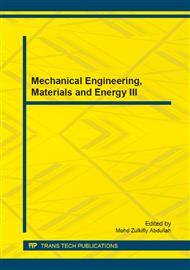[1]
Liu Guang-fu, Liu Xue-ping, Liu Zhi-feng. Structure of green design and implementation strategy[J]. China Mechanical Engineering, 2000, 11(9): 965-968.
Google Scholar
[2]
Liu Fei, Cao Hua-jun, He Nai-jun. Research status and development trend of green manufacturing[J]. China Mechanical Engineering, 2000, 11(1-2): 105-110.
Google Scholar
[3]
Li Fang-yi, Wang Jing-song, Li Jian-feng. Present situation and prospect of research on green design of products[J]. Aeronautical Manufacturing Technology, 2004, 29(10): 73-78.
Google Scholar
[4]
Lu Chang-ming, Chen Feng, Deng Jing-lian. Effect of green product design of the module[J]. Machine design and research, 2006, 22(6): 13-16.
Google Scholar
[5]
LiTing-ting, Gong Jing-zhong, Li Guo-xi. Maintenance module driven[J]. Manufacturing and research of machinery. 2007, 45(02): 166-168.
Google Scholar
[6]
Tseng H E, Chang C C, Li J D. Modular design to support green life-cycle engineering[J]. Expert Systems with Applications, 2008, 34(4): 2524-2537.
DOI: 10.1016/j.eswa.2007.04.018
Google Scholar
[7]
Guo Wei , Liu Guang-fu, Zhang-Lei. Research on green product module partition method oriented to the whole life cycle[J]. Journale of HeFei University of Technology( Natural Science Edition) 2010, 33(10): 1441-1445, 1449.
Google Scholar
[8]
Smith S, Yen C C. Green product design through product modularization using atomic theory [J]. Robotics and Computer Integrated Manufacturing, 2010, 26(6): 790-798.
DOI: 10.1016/j.rcim.2010.05.006
Google Scholar
[9]
Chen Xiao-bing. Research and application of green module partition method of electromechanical products[D]. Zhejiang University, (2012).
Google Scholar
[10]
Ji Y J, Jiao R J, Chen L, Wu C L. Green modular design for material efficiency: a leader–follower joint optimization model[J]. Journal of Cleaner Production, 2013, 41(2): 187-201.
DOI: 10.1016/j.jclepro.2012.09.022
Google Scholar
[11]
Tang Wen-yan, Wu Chun-yan, Ma Bao. Research aim. module partition method based on fuzzy clustering analysis[J]. Mechanical layout, 2012, 29(10): 24-28.
Google Scholar
[12]
Tang T-ao, Liu Zhi-feng, Liu Guang-fu. green module paitition design method research. Chinese Journale of Mechanical Engineering, 2003, 39(11): 149-154.
Google Scholar
[13]
Zhang Shi-fang, San Yang, Qin Chuan-dong. Dynamical fuzzy multiple attribute decision making of the WIKOR expansion method[J]. 2012, 18(1): 186-191.
Google Scholar
[14]
Wang Xiao-ping, Cao Li-ming. the theory of Genetic Algorithm [M]. Xi'an Jiao Tong University Press . 2002. 1: 28, 38.
Google Scholar
[15]
Liu Dian-ting, Zhou De-jian. Uncertain moduleing of production planning under the condition of SMT products and GA solution[J]. Journal of Guilin University of technology, 20118, 31(2): 278-285.
Google Scholar


